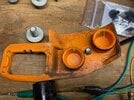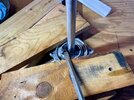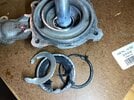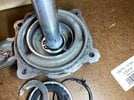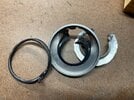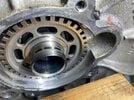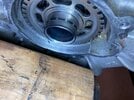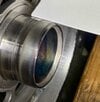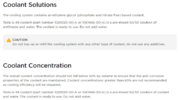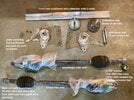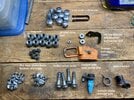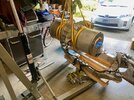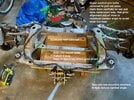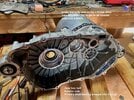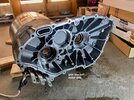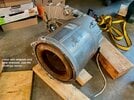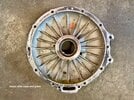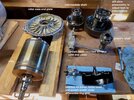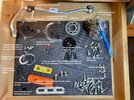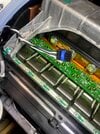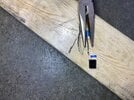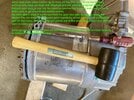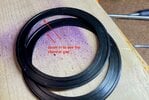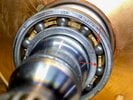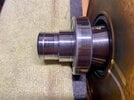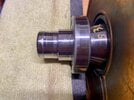Found both of rotor's non conductive bearing's grease completely shot from the coolant. The inner one (closer to gearbox) was worse than the outer one that is actually closer to the leaked seal. Rotor and stator surface also had rust on the inner end. Based on this and the inverter housing coolant location. LDU likely has a slight tilt towards passenger side when parked. Could be garage floor, subframe or LDU mount. Could be different depending on car and parking location and inverter drain mod may need to tap both end of casing. Pics here
Tesla Large Drive Unit (LDU) Motor Teardown and maintenance - Page 6 - openinverter forum
The non conductive rotor bearings (SFK hybrid bearing with silicon nitride non conductive balls) seems quite durable even though grease have long turned into something that looked and feel like cake icing. Additional tips on cleaning them off for re-grease per
@vanR's method in initial post
@vanR method doesn't remove the bearings but pop open both bearing seal and ball cage for cleaning while bearing is on the shaft. Its not easy to remove the bearing off the shaft on the inner ring face without potential damage (not much surface on inner ring face beyond the limit stop on the shaft)
Note this cleaning can take a couple of hours per bearing and will prep you for a dental hygienist qualifying examine

but new bearings at $400 each so figure you are earning $200/hr. Here are some of the tools you need
- finest tip flat head (2x)
- plastic pick/lever, fine tip metal pick,
- fine tip tweezer
- qtips (ideally ones that cotton fibers threads don't get loose or you may need to pick those out after cleaning, blue colored in my case)
- magnifying eye wear is really helpful to see close up and all details
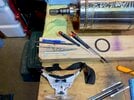 Pop off the outer seal (seal facing away from the rotor)
Pop off the outer seal (seal facing away from the rotor)
The seal has a metal body but coated with rubber on the outside. Top of the seal goes into a groove in the outer ring of the bearing. Botton of the seal is rubber that extend beyond the metal body which can be used to gain entry. Use your finest flat head screw driver to gain entry and eventually can leverage the top metal lip out of the bearing outer ring groove. Be careful as the internal ball bearing cage is plastic so don't want to break anything.
Note my spline side bearing was much worse caked than coolant seal side. Also note the bearing cages are facing different direction on both (this changes how to get them out and ease of cleaning)
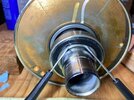
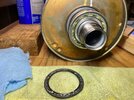
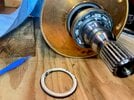 Get as much cake icing off as possible dry
Get as much cake icing off as possible dry
Per
@vanR, used acetone to clean off the gunk. But thats a thinner so just keeps on thinning the gunk. Good first step is to get as much of it out dry as possible. Takes longer thinning down the big chunks.
Pulling ball cage that comes out away from rotor
My coolant side bearing has cage that comes out away from the rotor. This cage can actually be completely removed (makes cleaning much easier) To remove, gently lever it out. 2 flat head fine tip drivers is helpful. After removal, dry clean off the big chunks followed by acetone + qtip.
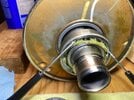 Pushing rear seal out
Pushing rear seal out
When the cage is removed, popping out the rear seal is actually quite difficult (much easier when cage is oriented the other way, see later section) Top metal body of the rear seal is stuck in bearing ring groove. End up using 2 broad and not sharp flat tipped tool about 1/2" to 1" apart to push the top metal lip out with a bit of force.
Pushing ball cage that goes towards the rotor
Cage has 2 arms that warps around the ball bearing in the center (think of equator) The trick to push the cage of the ball is to slightly bend this wrapping structure upwards so it clears the narrow part of the ball bearing (near north pole?) Do this to a couple of adjacent ball bearing cage arms and the cage will start to move backwards. The rear seal is relatively easy to push out. I think its because the cage have a large flat body in the back that pushes the seal out. So perhaps a tool with large thick flat frontal tip is whats necessary to push the other rear seal out (one with cage removed)
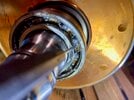
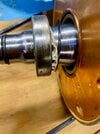
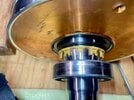 Cleaning the cage between bearing and rear seal/rotor
Cleaning the cage between bearing and rear seal/rotor
This where you will earn your dental hygienist degree. Lots of crevasses to get to and bottom of the cage. Back of the cage has narrow curves in both direction. Also need to get to the under side of the cage (inner ring) A fine pointy tip is good. Perhaps a sewing needle is good as its short enabling more positioning angles. Pulling paper towel pieces through is helpful
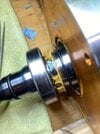 Get Some Grease
Get Some Grease
Here are the results. My pried out seal had no damage except maybe a slight bend where it was levered out. Easy to straighten the seal's metal frame. Need special grease. Review
@vanR's video. Website in my signature has pointers.
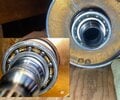
Hope the rotor spline side bearing is still good (will find out after greased) Had to hammer the rotor out as that bearing was stuck in its sleeve.



